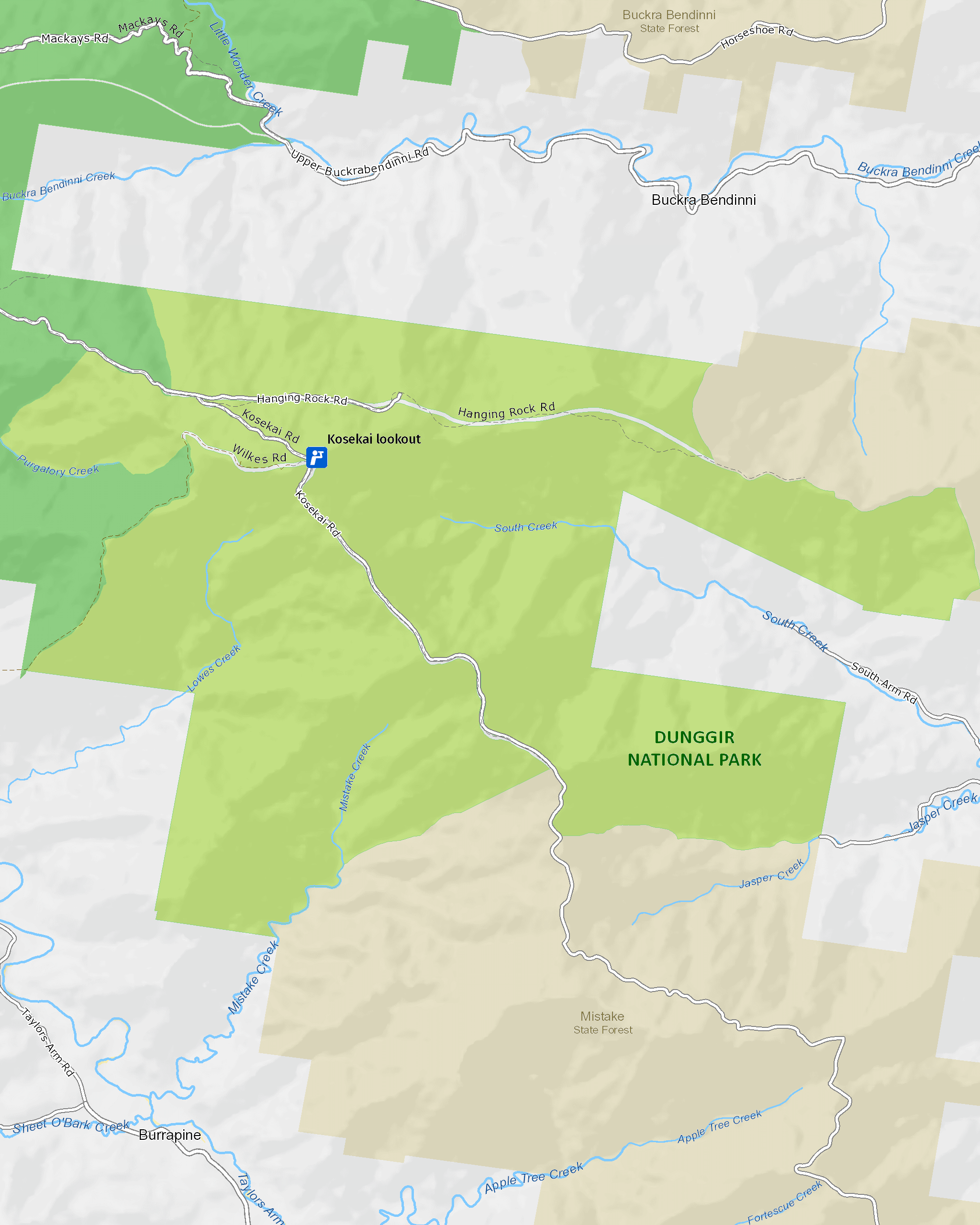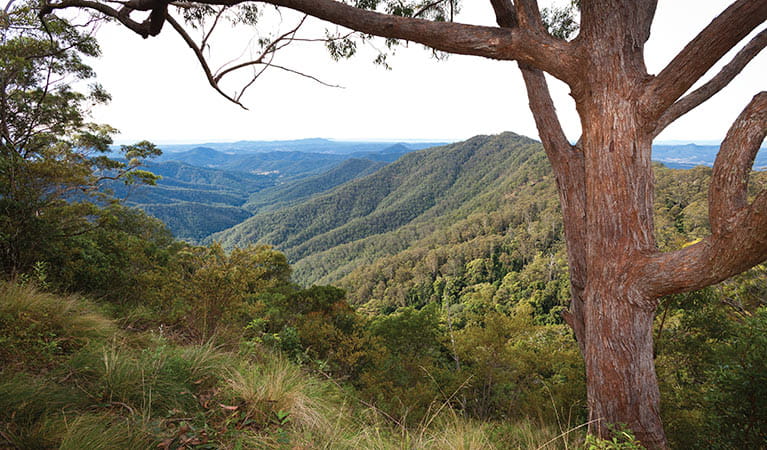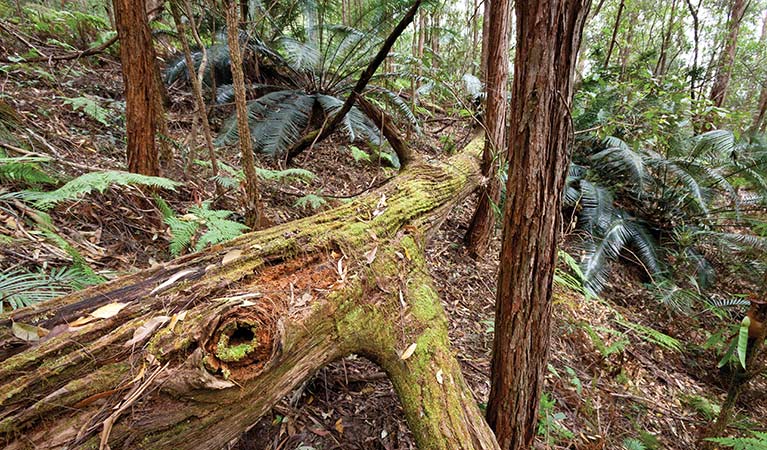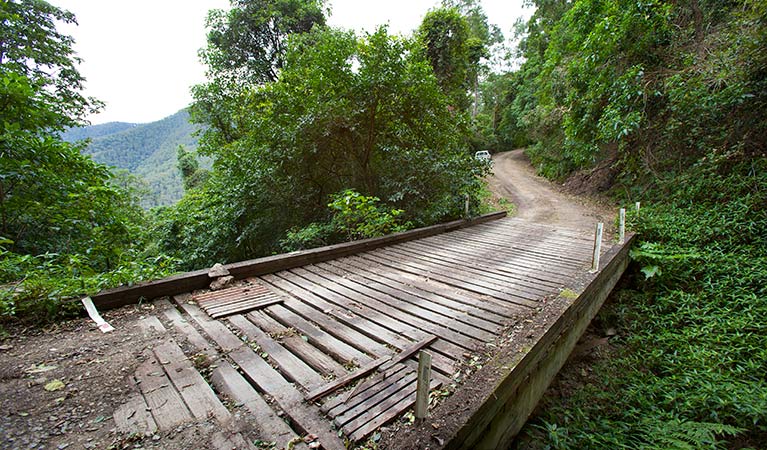Dunggir National Park
Dunggir National Park is a small reserve with some big draws: scenic driving routes, quiet picnic spots, a stellar lookout, and bushwalking for serious hiking.
Read more about Dunggir National Park
Dunggir is the Gumbaynggirr word for ‘koala,’ which tells you a great deal about what sort of national park this is – one with deep Aboriginal roots and precious native habitat. Indeed, the connection of Dunggir National Park to its traditional owners runs back countless generations; there are many sites of spiritual significance scattered throughout the rugged ridges of the landscape, and Gumbaynggirr People still visit them today for bush foods and medicine.
There are also at least twelve threatened animal species (including koalas and yellow-bellied gliders), 400 native plants, and three types of rainforest, though Dunggir is otherwise a low-key sort of place. It’s great for hiking and for visitors looking for a quiet picnic spot. A place of spectacular extremes, the park offers a stunning forest drive past tallow woods and ironbarks, and a must-see scenic lookout with wide views over the Nambucca Valley all the way to the coast. Not to mention some of the best birdwatching opportunities in the region.
Local alerts
For the latest updates on fires, closures and other alerts in this area, see https://www.nationalparks.nsw.gov.au/visit-a-park/parks/dunggir-national-park/local-alerts
Contact
- in the North Coast region
Dunggir National Park is always open but may have to close at times due to poor weather or fire danger.
-
-
Coffs Harbour office
02 6652 0900
Contact hours: Monday to Friday, 8.30am to 4.30pm. - 4/32 Edgar St, Coffs Harbour NSW 2450
-
Email: npws.coffscoast@environment.nsw.gov.au
-
Coffs Harbour office
Visitor info
All the practical information you need to know about Dunggir National Park.
Map

Map legend

Getting there and parking
Get driving directions
From Bowraville:
- Follow North Arm Road west from Bowraville for 2km
- Turn left into Buckra Bendinni Road and follow this for 7km
- Turn left into Hanging Rock Road and follow it for 11km to reach the park boundary
By bike
Check out the Bicycle information for NSW website for more information.
By public transport
Dunggir National Park is not accessible by public transport.
Best times to visit
There are lots of great things waiting for you in Dunggir National Park. Here are some of the highlights.
Spring
Spring offers the most comfortable temperatures to visit the park, and some hillsides bloom in the unmistakable red of flame trees, particularly around Kosekai lookout.
Winter
The crisp air of winter provides the clearest views of the surrounding region, so photographers should come mid-year or in late Autumn.
Weather, temperature and rainfall
Summer temperature
Average
17.4°C and 28.8°C
Highest recorded
43°C
Winter temperature
Average
6.3°C and 20.3°C
Lowest recorded
-1.8°C
Facilities
Picnic tables
Maps and downloads
Prohibited
Pets
Pets and domestic animals (other than certified assistance animals) are not permitted. Find out which regional parks allow dog walking and see the pets in parks policy for more information.
Smoking
NSW national parks are no smoking areas.
Nearby towns
Macksville (35 km)
Macksville is a relaxed fishing and oyster-farming town centre of a rich rural district. It's on low-lying land around the Nambucca River.
Nambucca Heads (43 km)
If you are looking for a sunny beach holiday, the climate in Nambucca Heads is close to perfect, with highs of around 27°C in summer, and 18°C in winter. The beach itself is great for learning how to surf, as the waves are mostly small. And when the surf life savers are out, you can enjoy a dip in the ocean.
South West Rocks (83 km)
South West Rocks is a sleepy coastal retreat at its barefoot best. It's an oceanfront holiday town on north-facing Trial Bay.
Learn more
Dunggir National Park is a special place. Here are just some of the reasons why:
Rich in Aboriginal culture

Dunggir National Park lies within the territory of the Gumbaynggir People - a territory extending from Grafton all the way south to Nambucca River. The park is named in respect to their Traditional Owners, and Gumbaynggir People continue to visit the area today for bush foods and medicines. Many features of the land and waterways, as well as local plants and animals, contribute to a rich heritage of dreaming stories and cultural learning that is passed down through generations. Bowra Sugarloaf, for example, the highest peak in the park, holds considerable spiritual significance. The NSW National Parks & Wildlife Service works with local Aboriginal communities to protect this heritage for the future.
Endangered animals

The steep, often inaccessible terrain means many of the animals that call Dunggir National Park home are difficult to see. But there are a whole range of birds, mammals, reptiles and amphibians, and the park features at least twelves species that are threatened or endangered, including the koala, powerful owl, spaghnum frog, and parma wallaby. Keep your eyes open in case you get lucky, and bring a pair of binoculars for superb birdwatching. You're sure to hear lyrebirds and the wompoo fruit-dove as you travel through the varied forest communities and terrain elevations.
- Kosekai lookout Kosekai lookout offers a scenic lookout over the expansive Nambucca Valley all the way to the coast, with picnic tables and good opportunities for birdwatching.
Education resources (1)
What we're doing
Dunggir National Park has management strategies in place to protect and conserve the values of this park. Visit the OEH website for detailed park and fire management documents.
General enquiries
- National Parks Contact Centre
- 7am to 7pm daily
- 1300 072 757 (13000 PARKS) for the cost of a local call within Australia excluding mobiles
- parks.info@environment.nsw.gov.au
Contact
- in the North Coast region
Dunggir National Park is always open but may have to close at times due to poor weather or fire danger.
-
-
Coffs Harbour office
02 6652 0900
Contact hours: Monday to Friday, 8.30am to 4.30pm. - 4/32 Edgar St, Coffs Harbour NSW 2450
-
Email: npws.coffscoast@environment.nsw.gov.au
-
Coffs Harbour office

